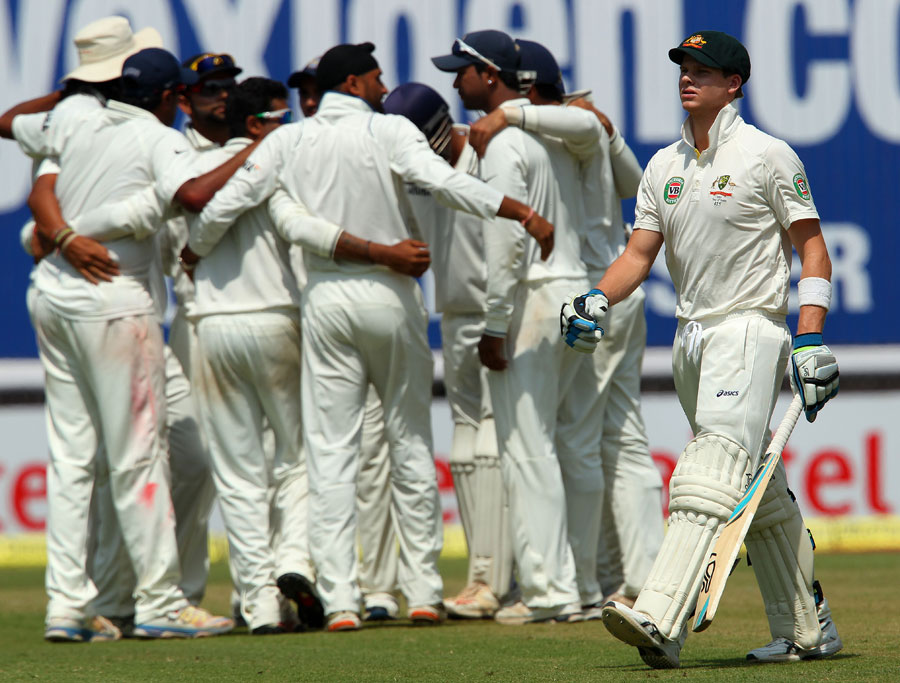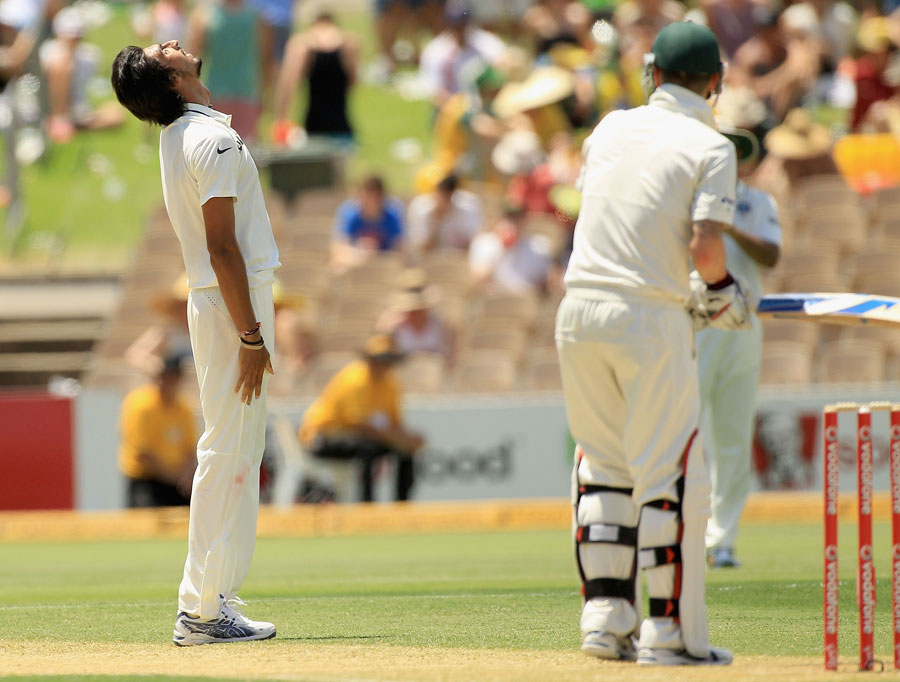
The 2013 Delhi Test was finished in three days. Ergo, was it a poor pitch? © BCCI
Enlarge
Cricket is one of those games where a question does not necessarily require a definitive answer. Merely exploring the parameters of the question provokes enough meaty debate to justify the question being asked in the first place. So on that basis, in the wake of the Ashes Test in Sydney, I pose this question: what defines a "good" Test pitch?
As this is a truly global forum, I expect a varied and sometimes passionate response from the four corners of the world. Assuming we can put aside the obvious patriotic bias, what are some of the qualities of a pitch that define it as good, bad or indifferent? Is it ultimately a question that can only be answered retrospectively, at the end of the game when the result is known, or is it possible to make a judgement call on it on the very first day (or relatively early in the match)?
Not long ago, a talkback caller on my weekly radio programme on the ABC was scathing in his criticism of all the pitches in India on Australia's most recent Test tour there, and similarly disdainful of most pitches in England on the last Ashes tour. When I pointed out some facts, he reluctantly conceded that his bias had been fed by lazy cricket writers who were looking for a populist audience, and we then enjoyed a more useful debate about how easy it was to succumb to an argument based on jingoism rather than cricketing knowledge.
So what defines a good pitch then? Is it a pitch where:
Plenty of runs scored at a rate of 3-plus?
Barring bad weather, a game reaches a conclusion some time after tea on day four?
Fast bowlers and spinners have equal opportunities to take wickets (proportionately of course, given that it's usually three quicks and one spinner)?
A few centuries but not too many are made?
The ball carries through to the keeper until about day four, after which uneven bounce becomes more prevalent? (And if there is no uneven bounce late in the game, is that a sign of a poor pitch?)
Conditions do not favour either side to any great extent (keeping in mind the accusations of "doctored" pitches sometimes levelled at home teams)?
The toss of the coin doesn't effectively determine the outcome of the match?
I personally believe home teams are entitled to prepare pitches to suit their strengths. It is up to the visitors to select a team that can cope with those conditions. If the game goes deep into day four and beyond, it suggests a relatively even contest, not necessarily in terms of an outright victor but at least the possibility of a draw. The common thinking that associates "good" with bounce, carry, pace is one of the great misnomers. Cricket's complex global appeal lies in the fact that trying to tame Mitchell Johnson at home on a bouncy deck is as much of a challenge as coping with wily New Zealand seamers on a greentop, or using your feet against three slow bowlers on a pitch that turns from the first day. The notion that it should do plenty for the fast bowlers through the match but shouldn't turn for the spinners from the outset is a theory clearly propounded by those unable to bowl spin or bat against it.
Let's look then at the most recent home Tests played by every country and leave it up to the readers to decide which of these Tests were played on "good" pitches. Remember that this is only a small sample size and invariably favours the home team, but is that enough of a reason to refer to the pitches as "doctored"? Don't most teams struggle to win away from home? In this list (below), not one visiting team won a game but how many of the local media outlets made excuses about "home-town" pitches?
Bangladesh v NZ, Mirpur. Match drawn. Bangladesh 282 all out, NZ 437 all out, Bangladesh 269 for 3. No play on day five.
Zimbabwe v Pakistan, Harare. Zimbabwe won by 24 runs. Zimbabwe 294 all out, Pakistan 230 all out, Zimbabwe 199 all out, Pakistan 239 all out. Match concluded just after lunch on day five.
West Indies v Zimbabwe, Dominica. West Indies won by an innings and 65 runs. Zimbabwe 175 all out, West Indies 381 for 8 decl, Zimbabwe 141 all out. Match concluded after lunch on day three.
South Africa v India, Durban. South Africa won by ten wickets. India 334 all out, South Africa 500 all out, India 223 all out, South Africa 59 for 0. Match concluded after tea on day five.
England v Australia, London (The Oval). Match drawn. Australia 492 for 9 decl, England 377 all out, Australia 111 for 6 decl, England 206 for 5 (21 runs short). Match concluded day five, close of play.
India v West Indies, Mumbai. India won by an innings and 126 runs. West Indies 182 all out, India 495 all out, West Indies 187 all out. Match concluded before lunch on day three.
New Zealand v West Indies, Hamilton. New Zealand won by eight wickets. West Indies 367 all out, New Zealand 349 all out, West Indies 103 all out, New Zealand 124 for 2. Match concluded after lunch on day four.
Pakistan v Sri Lanka, Abu Dhabi. Match drawn. Sri Lanka 204 all out, Pakistan, 383 all out, Sri Lanka 480 for 5 decl, Pakistan 158 for 2. Match concluded day five, close of play.
Australia v England, Sydney. Australia won by 281 runs. Australia 326 all out, England 155 all out, Australia 276 all out, England 166 all out. Match concluded after tea on day three.
At first glance, I would nominate The Oval, Harare, Colombo and Durban as examples of excellent pitches, but does that necessarily make the others poor? Sydney, for example, barely lasted three days and clearly favoured the home team, but there should rightly be no talk of doctored pitches. England inspected the pitch, selected their best team, won the toss and were still thrashed by a vastly superior Australian outfit. Despite fine centuries from Steve Smith and Chris Rogers, 24 wickets fell on the first two days. Would the Australian media have been silent if that happened in Galle or Chennai? The resoundingly better team triumphed in Sydney, regardless of conditions that clearly favoured their strengths. Similarly when Australia toured India in 2013, despite winning all four tosses, they simply weren't good enough on pitches that suited India's skills. Delhi was the only venue that saw a result late on day three, and was labelled a disgrace by the Australian media, who will now be deafeningly silent about the early finish in Sydney, no doubt. Hence my earlier question - do we only judge a pitch retrospectively after we see who wins?
The recent Ashes series in England was written up by many in the Australian media as being played on "blatantly doctored pitches". Most of these cricket writers are journalists who never really played cricket to any significant level and are therefore sucked into the trap of making excuses that they think will resonate with readers who are supposedly dumb and easily seduced by an appeal to blind patriotism. But they misjudge us badly - the true Australian cricket fan understands the nuances of this great game and can appreciate skill, however it is wrapped, pace or spin. There will, of course, be that small vocal minority that only wants to read about good news (or excuses) but fortunately they are unlikely to be reading a global cricket website like this - the local tabloids will cater adequately to their coarse needs and hoarse voices.

